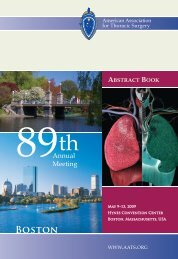Disclosure Slide - AATS: Member Login
Disclosure Slide - AATS: Member Login
Disclosure Slide - AATS: Member Login
Create successful ePaper yourself
Turn your PDF publications into a flip-book with our unique Google optimized e-Paper software.
<strong>Disclosure</strong> <strong>Slide</strong><br />
• Dr Puskas is PI of the “Hybrid<br />
Revascularization Observational Study”<br />
(Challenge Grant #1RC1HL100951-01)<br />
and has an intense clinical and research<br />
interest in HCR.<br />
• No other conflicts of interest relevant to<br />
this presentation or proposed trial.
Hybrid Coronary Revascularization:<br />
Collaborative Innovation Combining Surgical<br />
and Percutaneous Therapies for Selected Patients<br />
with Coronary Artery Disease<br />
John D. Puskas MD, MSc, FACC, FACS<br />
NHLBI Cardiothoracic Surgery Network<br />
PI, Emory University Site
Background:<br />
• Syntax trial : CABG offers better survival and intervention-free<br />
survival than PCI with DES for LM and multivessel CAD, at the<br />
cost of increased perioperative morbidity, including greater risk of<br />
stroke.<br />
• LITA-LAD provides much of the mortality benefit of CABG.<br />
• DES are considered by some to be equivalent to saphenous vein<br />
grafting to non-LAD coronary target vessels.<br />
• While multiple arterial grafting may be better, few patients receive<br />
bilateral ITA or all-arterial grafting in the USA.<br />
• Many patients with multivessel disease are treated with multivessel<br />
PCI rather than CABG, in part due to strong patient preference<br />
for a less invasive therapy.
Rationale:<br />
• Hybrid coronary revascularization (HCR) seeks to combine<br />
the best features of surgical coronary revascularization with<br />
LITA grafting of the LAD coronary artery and PCI of non-<br />
LAD coronary targets with DES.<br />
• Avoids aortic clamping, cardiopulmonary bypass,<br />
sternotomy and their morbidities, including stroke<br />
• Provides survival benefit of LITA-LAD, avoiding DES-LAD<br />
• Will come at cost of reintervention associated with DES to<br />
non-LAD coronary arteries<br />
• HCR represents an important, innovative collaboration<br />
between surgery and cardiology.
Aims and Methods:<br />
• The proposed pivotal multicenter, prospective, randomized,<br />
controlled trial (RCT) would test the safety, efficacy and<br />
comparative effectiveness of HCR versus multivessel PCI for<br />
patients with multivessel CAD deemed amenable to either<br />
treatment by the local multidisciplinary Heart Team.<br />
• HCR group: off-pump, non-sternotomy, minimally invasive<br />
surgical grafting of the LAD with the LITA; non-LAD lesions<br />
>70% would be treated by PCI with DES. Surgical and PCI<br />
components of the HCR may be staged (in either order) by<br />
minutes or up to 6 weeks.<br />
• PCI group: DES-LAD and DES to non-LAD vessels<br />
• Dual antiplatelet medical therapy for all patients.
Eligibility Criteria<br />
• Informed by the Challenge Grant-funded Hybrid<br />
Observational Study, eligibility criteria will include:<br />
• coronary anatomy (multivessel and LM CAD) deemed<br />
suitable for HCR or PCI with DES by the Heart Team at<br />
each enrolling site<br />
• ability to tolerate dual antiplatelet medical therapy<br />
• Excluded:<br />
• Emergency status or prior CABG<br />
• Chronic total occlusion in LAD or > 2 CTOs in targets<br />
• Evolving acute myocardial infarction (
Proposed RCT of Hybrid Coronary Revascularization<br />
• Hypothesis: HCR will be as safe and more effective than multivessel PCI for<br />
patients with multivessel CAD amenable to either treatment<br />
• Primary Endpoint: composite of death, stroke, MI, and repeat revascularization<br />
at 24 months<br />
• Preplanned secondary endpoints:<br />
• composite endpoint at 1, 3 and 5 years follow-up<br />
• post-procedural length of stay<br />
• cost during index hospitalization<br />
• individual components of the primary endpoint and quality of life (Seattle Angina<br />
Questionnaire and SF-36) annually during five years follow-up.<br />
• Other goals: to determine<br />
• which patients benefit most from HCR<br />
• which patterns of CAD are most suitable for HCR, esp LM vs. multivessel CAD.<br />
• the relative effectiveness of alternative minimally invasive surgical approaches to the<br />
LITA-LAD procedure (including role of robotics)
















